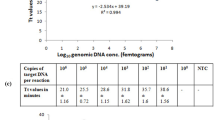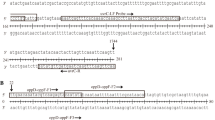Abstract
Bacillus anthracis, the causative agent of anthrax is one of the most potent listed biological warfare agents. The conventional microbiological methods of its detection are labor intensive and time consuming, whereas molecular assays are fast, sensitive and specific. PCR is one of the most reliable diagnostic tools in molecular biology. The combination of PCR with lateral flow strips can reduce the diagnostic/detection time. It gives an alternative to gel electrophoresis and offers easy and clear interpretation of results. In the present study, a PCR Lateral flow (PCR-LF) assay targeting cya gene present on pXO1 plasmid of B. anthracis has been developed. The forward and reverse primers were tagged with 6-carboxyflourescein (6-FAM) and biotin, respectively, at 5′ end. The dual labeled PCR products were detected using lateral flow (LF) strips developed in this study. The PCR-LF assay could detect ≥ 5 pg of genomic DNA and ≥ 500 copies of target DNA harboured in a recombinant plasmid. The assay was able to detect as few as 103 and 10 CFU/mL of B. anthracis Sterne cells spiked in human blood after 6 and 24 h of enrichment, respectively.




Similar content being viewed by others
References
Spencer, R. C. (2003). Bacillus anthracis. Journal of Clinical Pathology, 56, 182–187
Goel, A. K. (2015). Anthrax: A disease of biowarfare and public health importance. World Journal of Clinical Cases, 3, 20–33
Collier, R. J., & Young, J. A. (2003). Anthrax toxin. Annual Review of Cell and Developmental Biology, 19, 45–70
Turnbull, P. C. (1999). Definitive identification of Bacillus anthracis—A review. Journal of Applied Microbiology, 87, 237–240
Welkos, S. L., Keener, T. J., & Gibbs, P. H. (1986). Differences in susceptibility of inbred mice to Bacillus anthracis. Infection and Immunity, 51, 795–800
Blažková, M., Koets, M., Rauch, P., & van Amerongen, A. (2009). Development of a nucleic acid lateral flow immunoassay for simultaneous detection of Listeria spp. and Listeria monocytogenes in food. European Food Research and Technology, 229, 867
Zhuang, L., Ji, Y., Tian, P., Wang, K., Kou, C., Gu, N., & Zhang, Y. (2019). Polymerase chain reaction combined with fluorescent lateral flow immunoassay based on magnetic purification for rapid detection of canine parvovirus 2. BMC Veterinary Research, 15, 30
Takada, K., Sakaguchi, Y., Oka, C., & Hirasawa, M. (2005). New rapid polymerase chain reaction-immunochromatographic assay for Porphyromonas gingivalis. Journal of Periodontology, 76, 508–512
Fayad, N., Kallassy Awad, M., & Mahillon, J. (2019). Diversity of Bacillus cereus sensu lato mobilome. BMC Genomics, 20, 436
Marston, C. K., Gee, J. E., Popovic, T., & Hoffmaster, A. R. (2006). Molecular approaches to identify and differentiate Bacillus anthracis from phenotypically similar Bacillus species isolates. BMC Microbiology, 6, 22
Helgason, E., Okstad, O. A., Caugant, D. A., Johansen, H. A., Fouet, A., Mock, M., Hegna, I., & Kolsto, A. B. (2000). Bacillus anthracis, Bacillus cereus, and Bacillus thuringiensis-one species on the basis of genetic evidence. Applied and Environment Microbiology, 66, 2627–2630
Ghosh, N., Tomar, I., & Goel, A. K. (2013). A field usable qualitative anti-protective antigen enzyme-linked immunosorbent assay for serodiagnosis of human anthrax. Microbiology and Immunology, 57, 145–149
Ghosh, N., & Goel, A. K. (2012). Anti-protective antigen IgG enzyme-linked immunosorbent assay for diagnosis of cutaneous anthrax in India. Clinical and Vaccine Immunology, 19, 1238–1242
Varshney, A., Puranik, N., Kumar, M., Pal, V., Padmaja, J., & Goel, A. K. (2019). An ELISA using a recombinant chimera of protective antigen and lethal factor for serodiagnosis of cutaneous anthrax in India. Biologicals, 57, 55–60
Puranik, N., Kumar, M., Tripathi, N., Pal, V., & Goel, A. K. (2019). A rapid flow through membrane enzyme linked immunosorbent assay for Bacillus anthracis using surface array protein as a biomarker. Defence Science Journal, 69, 348–352
Koczula, K. M., & Gallotta, A. (2016). Lateral flow assays. Essays in Biochemistry, 60, 111–120
Puranik, N., Pal, V., Tripathi, N. K., & Goel, A. K. (2020). Development of a rapid immunochromatographic assay for detection of surface array protein (Sap), a potent biomarker of Bacillus anthracis. Biologia, 75, 613–617
Gates-Hollingsworth, M. A., Perry, M. R., Chen, H., Needham, J., Houghton, R. L., Raychaudhuri, S., Hubbard, M. A., & Kozel, T. R. (2015). Immunoassay for capsular antigen of Bacillus anthracis enables rapid diagnosis in a rabbit model of inhalational anthrax. PLoS ONE, 10, e0126304
Buscher, P. (2011). Nucleic acid lateral flow tests for molecular diagnosis: An update. Expert Opinion on Medical Diagnostics, 5, 85–89
Zhang, P., Liu, X., Wang, C., Zhao, Y., Hua, F., Li, C., Yang, R., & Zhou, L. (2014). Evaluation of up-converting phosphor technology-based lateral flow strips for rapid detection of Bacillus anthracis spore, Brucella spp., and Yersinia pestis. PLoS ONE, 9, e105305
Baeumner, A. J., Leonard, B., McElwee, J., & Montagna, R. A. (2004). A rapid biosensor for viable B. anthracis spores. Analytical and Bioanalytical Chemistry, 380, 15–23
Leppla, S. H. (1982). Anthrax toxin edema factor: A bacterial adenylate cyclase that increases cyclic AMP concentrations of eukaryotic cells. Proceedings of National Academy of Sciences USA, 79, 3162–3166
Pena-Gonzalez, A., Rodriguez, R. L., Marston, C. K., Gee, J. E., Gulvik, C. A., Kolton, C. B., Saile, E., Frace, M., Hoffmaster, A. R., & Konstantinidis, K. T. (2018). Genomic characterization and copy number variation of Bacillus anthracis plasmids pXO1 and pXO2 in a historical collection of 412 strains. mSystems. https://doi.org/10.1128/mSystems.00065-18
Liang, X., Zhang, H., Zhang, E., Wei, J., Li, W., Wang, B., Dong, S., & Zhu, J. (2016). Identification of the pXO1 plasmid in attenuated Bacillus anthracis vaccine strains. Virulence, 7, 578–586
Schade, R., Calzado, E. G., Sarmiento, R., Chacana, P. A., Porankiewicz-Asplund, J., & Terzolo, H. R. (2005). Chicken egg yolk antibodies (IgY-technology): A review of progress in production and use in research and human and veterinary medicine. Alternatives to Laboratory Animals, 33, 129–154
Acknowledgements
The authors are thankful to Director, DRDE, Gwalior for providing necessary facilities for this study (Acc No HR-2020-81). SB is thankful to Department of Biotechnology (DBT), Ministry of Science & Technology, Government of India for providing Senior Research Fellowship.
Author information
Authors and Affiliations
Corresponding author
Ethics declarations
Conflict of interest
The authors declare that they have no conflict of interest.
Ethical Approval
All the animal experiments were performed according to the Institutional Animal Ethics Committee (IAEC) vide registration number 37/1999/CPCSEA. The study was also approved by Institutional Biosafety Committee of Defence Research and Development Establishment, DRDO, Ministry of Defence, Government of India wide protocol no: BPT-02/58/AKG.
Additional information
Publisher's Note
Springer Nature remains neutral with regard to jurisdictional claims in published maps and institutional affiliations.
Rights and permissions
About this article
Cite this article
Banger, S., Pal, V., Tripathi, N.K. et al. Development of a PCR Lateral Flow Assay for Rapid Detection of Bacillus anthracis, the Causative Agent of Anthrax. Mol Biotechnol 63, 702–709 (2021). https://doi.org/10.1007/s12033-021-00335-6
Received:
Accepted:
Published:
Issue Date:
DOI: https://doi.org/10.1007/s12033-021-00335-6




